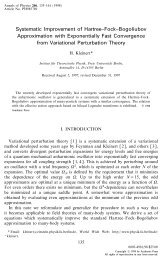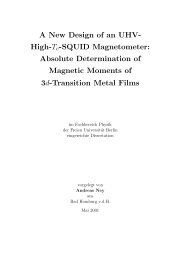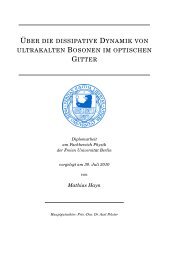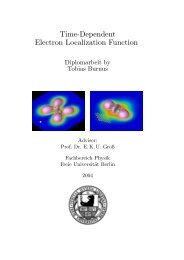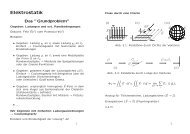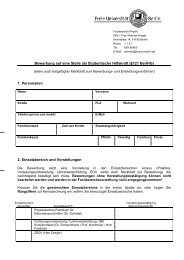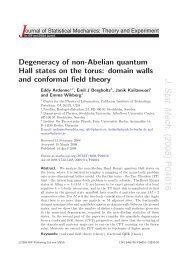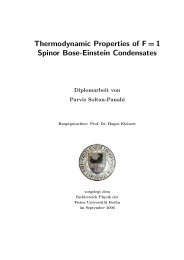Diploma thesis
Diploma thesis
Diploma thesis
Create successful ePaper yourself
Turn your PDF publications into a flip-book with our unique Google optimized e-Paper software.
3 Complex square well potential<br />
away but we can see again that even for τ = 0.2 only this k-state remains while the n-state has<br />
already nearly vanished.<br />
3.4 Related Systems<br />
The last section of this chapter is dedicated to some related systems. On the one hand we<br />
consider the asymmetric potential where area 1 and 3 do not yield the same extension and which<br />
thus represents a generalization of our so far regarded system. From this we will get an impression<br />
in what extent the particular symmetry influences our system and w will be able to evaluate an<br />
appropriate interpretation of (3.34). On the other hand we compare the results of our model with<br />
these two quite similar real valued systems in order to underline new properties the potential well<br />
exhibits only in the complex case.<br />
3.4.1 Asymmetric complex square well potential<br />
So let us first consider the asymmetric complex potential well as depicted in Fig. 3.11, that means<br />
area 1 and 3 do not yield the same width but l for area 1 and L ≠ l for area 3.<br />
⎧<br />
⎨ 0 , −l < x < L<br />
V R (x) =<br />
⎩ ∞ , otherwise<br />
(3.37)<br />
⎧<br />
⎨ −C = const. , |x| < w ≤ min{l, L}<br />
V I (x) =<br />
⎩ 0 , otherwise<br />
(3.38)<br />
Figure 3.11: Schematic sketch of the asymmetric complex potential well where the interval −l ≤<br />
x < −w represents area 1, −w ≤ x ≤ +w area 2 and w < x ≤ L area 3.<br />
The Hamiltonian of this system is thus not symmetric with respect to x = 0 so its eigenfunctions<br />
do not have a defined parity any more. Therefore we only have to deal with one quantization<br />
condition for all states instead of separating between symmetric and antisymmetric states:<br />
0 = (ε + ic) sin [ √ ε(ω − λ)<br />
]<br />
sin<br />
[√ ε(ω − Λ)<br />
]<br />
− { √<br />
ε + ic sin<br />
[√ ε(ω − Λ)<br />
]<br />
cos<br />
(<br />
2ω<br />
√<br />
ε + ic<br />
)<br />
−<br />
√ ε cos<br />
[√ ε(ω − Λ)<br />
]<br />
sin<br />
(<br />
2ω<br />
√<br />
ε + ic<br />
)}<br />
× { √<br />
ε + ic sin<br />
[√ ε(ω − λ)<br />
]<br />
cos<br />
(<br />
2ω<br />
√<br />
ε + ic<br />
)<br />
−<br />
√ ε cos<br />
[√ ε(ω − λ)<br />
]<br />
sin<br />
(<br />
2ω<br />
√<br />
ε + ic<br />
)}<br />
.<br />
(3.39)<br />
Here we introduced dimensionless variables similar to (3.24), but replaced 2L by the width of<br />
the asymmetric well, that is L + l so that Λ + λ = π. The symmetric limit is thus reached for<br />
Λ = π = λ, which we are familiar with. Consequently if we insert this into (3.39) we will obtain<br />
2<br />
both the quantization conditions for the symmetric (3.26) as well as the antisymmetric states<br />
(3.27). Solving (3.39) numerically yields for the energy:<br />
26




